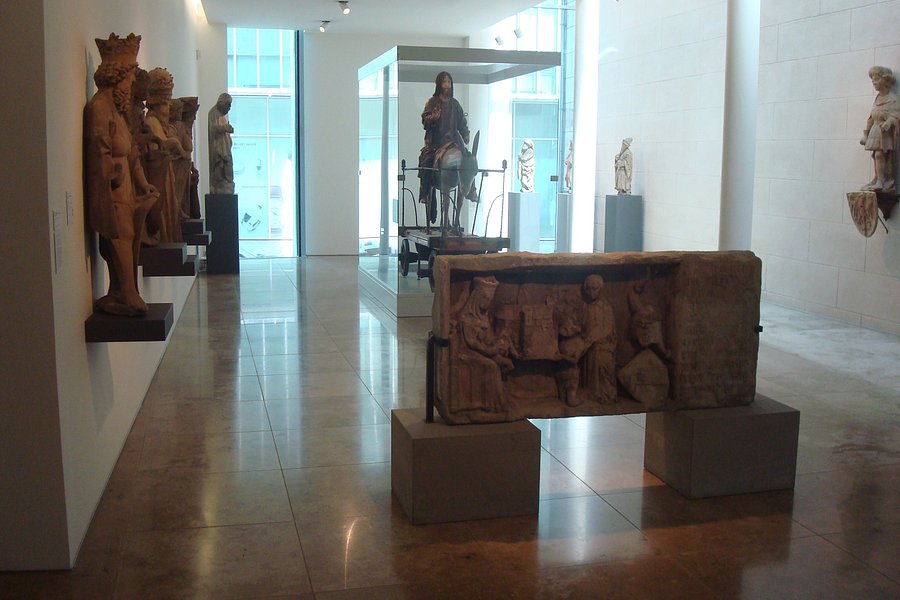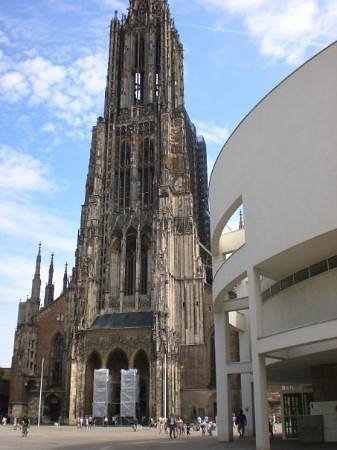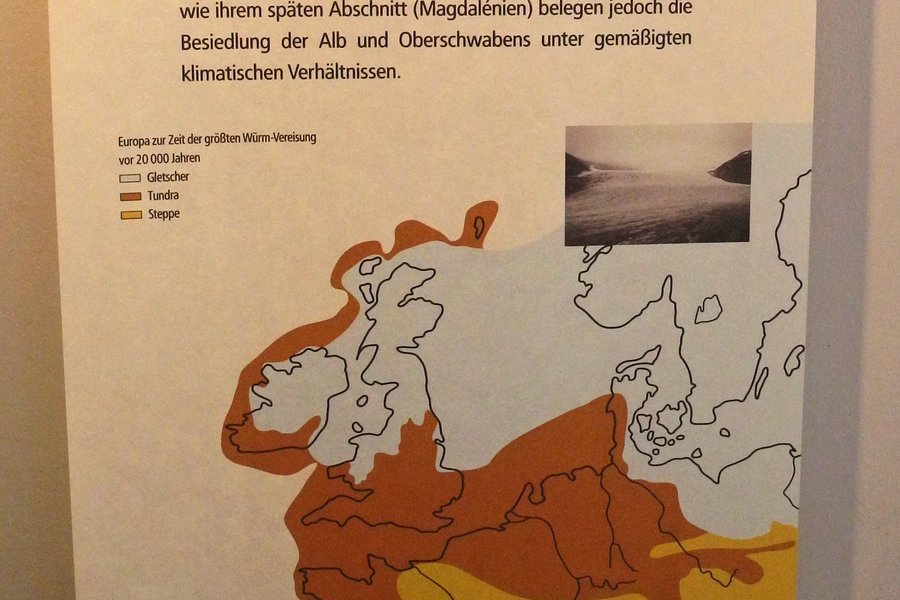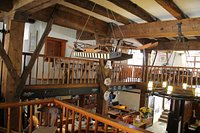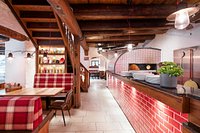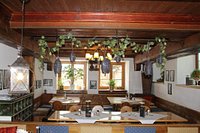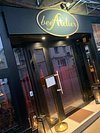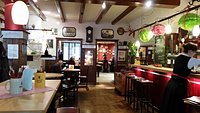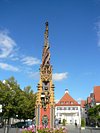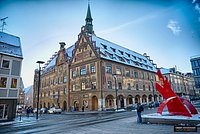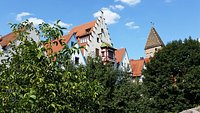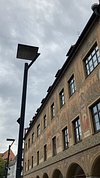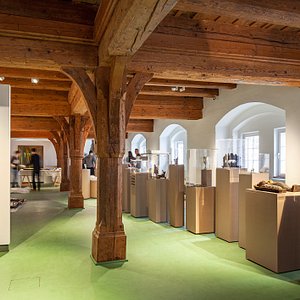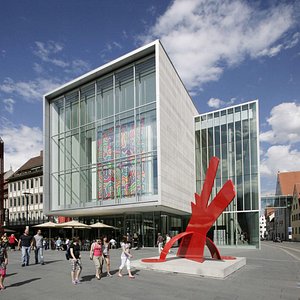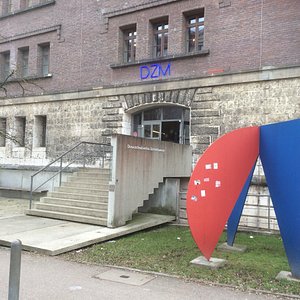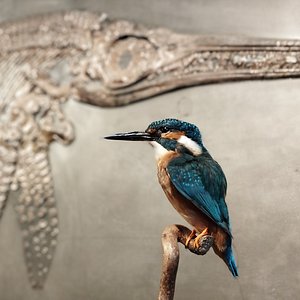Museum Ulm
Museum Ulm
4.5
Full view


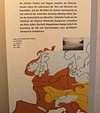




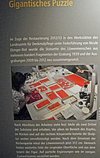
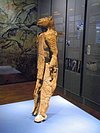
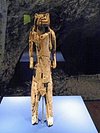
Top ways to experience nearby attractions
The area
Address
Reach out directly
Best nearby
Restaurants
413 within 3 miles
Attractions
93 within 6 miles
Contribute
Most Recent: Reviews ordered by most recent publish date in descending order.
Detailed Reviews: Reviews ordered by recency and descriptiveness of user-identified themes such as wait time, length of visit, general tips, and location information.
4.5
66 reviews
Excellent
34
Very good
19
Average
12
Poor
0
Terrible
1
sheldrake71
Lille, France41 contributions
Jul 2017
I visited Ulm and this museum last July. I was impressed by the the fact you get to see two museums in one: meaning modern and more traditional pieces of work. The building itself is very interesting architecturally speaking. The staff is very kind and the collections are simply amazing (the modern art installations!). I spent a good three hours there without feeling bored a single minute! :o)
Written June 18, 2018
This review is the subjective opinion of a Tripadvisor member and not of Tripadvisor LLC. Tripadvisor performs checks on reviews as part of our industry-leading trust & safety standards. Read our transparency report to learn more.
Chris W
Sydney, Australia190 contributions
Dec 2017 • Solo
I visited the museum as it was close to where I was staying and I had heard about an attraction they had on display. Mainly the lion man.
I do like museums and they have a huge display of many items of historical interest. But the building is very complicated to get around and you could easily get lost.
One criticism, which extends to a lot of museums, especially in Germany, is that they don't have a lot of English descriptions or pamphlets. It makes it very hard when inside a museum like this with lots to look at.
A positive was one of the curators took the time to explain some items to me and take me to the rooftop for a look at some art installations up there.
I do like museums and they have a huge display of many items of historical interest. But the building is very complicated to get around and you could easily get lost.
One criticism, which extends to a lot of museums, especially in Germany, is that they don't have a lot of English descriptions or pamphlets. It makes it very hard when inside a museum like this with lots to look at.
A positive was one of the curators took the time to explain some items to me and take me to the rooftop for a look at some art installations up there.
Written February 7, 2018
This review is the subjective opinion of a Tripadvisor member and not of Tripadvisor LLC. Tripadvisor performs checks on reviews as part of our industry-leading trust & safety standards. Read our transparency report to learn more.
Raroboy
Canada544 contributions
Sep 2015 • Couples
We went here for 2 reasons. 1. You can climb the 700 plus steps to the top of the worlds tallest Cathedral. 2. The Lion Man. 40,000 years old, hard to wrap my brain around that one. There are also some very old paintings by some famous painters.
Written October 11, 2015
This review is the subjective opinion of a Tripadvisor member and not of Tripadvisor LLC. Tripadvisor performs checks on reviews as part of our industry-leading trust & safety standards. Read our transparency report to learn more.
Maggie C
24 contributions
Jun 2015 • Couples
We had heard about the wonderful collections at the Ulmer Museum, including the "Lion Man", the 30,000 year old sculpture, and the first known zoomorphic (animal shaped) sculpture in the world. We were somewhat dismayed when we came into the museum, and we obviously interrupted a conversation between two employees. The person who gave us our ticket was unhospitable, and even though she realized we spoke English, did not offer us an English guide, nor an audio guide. ( We didn't see any either). We headed into the center of the museum, but since we did not pay extra for the special current exhibit, it was a mystery as to where we should go. We took the elevator to the 1st floor, but that was also the special exhibit. So we headed up to the 2nd floor, ready to give up. The first collection we saw was modern art, Paul Klee, Litchtenstein, fantastic and well displayed. No english captions, not one. No one in the museum. We headed up the stairs to a collection of maps and an exhibit of what we thought was a family collection of paintings, carved furniture, wardrobe, ceilings, chandeliers, it was incredible. Again, no captions. When we got to this floor, we were met by a nice man who worked there and he showed us how to get upstairs to the sculpture garden on the roof ( he spoke French). We wouldn't have known it was there, as there are no guides, except for this wonderful employee.You can see the Munster from the roof, the view is great.
The last exhibit we viewed was the archeological exhibit. It is well designed, with a collection that museums across the world would be salivating over, ending with the incredible lion man sculpture. The design was so good, we understood what was going on, despite...no guidance.
Museums across the world would love to have these collections. Yet, the lack of guidance, a sense of welcome to visitors, the modern layout of the museum which results in the rooms being disjointed, makes visitors very confused and dismayed ( read previous views). It is a shame.
The last exhibit we viewed was the archeological exhibit. It is well designed, with a collection that museums across the world would be salivating over, ending with the incredible lion man sculpture. The design was so good, we understood what was going on, despite...no guidance.
Museums across the world would love to have these collections. Yet, the lack of guidance, a sense of welcome to visitors, the modern layout of the museum which results in the rooms being disjointed, makes visitors very confused and dismayed ( read previous views). It is a shame.
Written June 30, 2015
This review is the subjective opinion of a Tripadvisor member and not of Tripadvisor LLC. Tripadvisor performs checks on reviews as part of our industry-leading trust & safety standards. Read our transparency report to learn more.
Doreen T
Aldershot, UK22 contributions
Dec 2013 • Couples
Was there today - had to pay extra to see the "lion man" which is part of their permanent collection. No one could tell us where any of the modern art paintings by Rothko, Warho, et al were housed...only that they have been mved. No one could tell us where they were moved to. Weasked several people and no one could tell us anything even when we pointed to the exhibits we wanted to see. We have been to hundreds of museums and this was the most frustrating. This was mediocre at best.
Written December 4, 2013
This review is the subjective opinion of a Tripadvisor member and not of Tripadvisor LLC. Tripadvisor performs checks on reviews as part of our industry-leading trust & safety standards. Read our transparency report to learn more.
Neale8
20 contributions
Jun 2017 • Couples
The lion man is the only decent exhibit. The museum is like a random collection of stuff. Most neolithic exhibits are replicas and fail to say where they were found. Blaubeuren museum is much better.
Written June 6, 2017
This review is the subjective opinion of a Tripadvisor member and not of Tripadvisor LLC. Tripadvisor performs checks on reviews as part of our industry-leading trust & safety standards. Read our transparency report to learn more.
Taff122
London, UK84 contributions
Aug 2015 • Couples
The Lion Man is an amazing exhibit. It is incredible to think that it is 40,000 old. There are also many other outstanding works of art on display here - paintings by Picasso, Klimt etc. A female member of staff went out of her way to be helpful.
Written September 3, 2015
This review is the subjective opinion of a Tripadvisor member and not of Tripadvisor LLC. Tripadvisor performs checks on reviews as part of our industry-leading trust & safety standards. Read our transparency report to learn more.
mollyfolly
Bitburg, Germany111 contributions
Aug 2015 • Solo
I only had time for the archaeological exhibit featuring the reconstructed Lionman (32,000-40,000) years old and originally carved from a single ivory tusk. Fragments were found in a cave and meticulously re-assembled with an estimated 400 hours of work. Most of the signage is only in German, but many of the exhibits are self-explanatory with careful observation. There are also medieval statues and modern paintings (many Matisses judging from the postcards). The museum is worth a 3-4 hour visit.
Written August 3, 2015
This review is the subjective opinion of a Tripadvisor member and not of Tripadvisor LLC. Tripadvisor performs checks on reviews as part of our industry-leading trust & safety standards. Read our transparency report to learn more.
dnvpaul
Kew Gardens, NY271 contributions
Aug 2012 • Solo
Housed in both old and new buildings, the Ulm museum features a nice permanent collection of the ancient history of Ulm and art from the middle-ages. The newer addition to the museum was beautifully designed and includes excellent gallery spaces. The location on the Marktplatz makes it convenient to see the Rathaus and walk to the Danube. Personnel at the museum were exceptionally friendly and helpful!
Written August 23, 2012
This review is the subjective opinion of a Tripadvisor member and not of Tripadvisor LLC. Tripadvisor performs checks on reviews as part of our industry-leading trust & safety standards. Read our transparency report to learn more.
periandro
Luxembourg City, Luxembourg7,839 contributions
Aug 2018 • Solo
The Ulm city Museum is exclusively oriented to History of Art and Culture. It a nice building in renaissance style which was inaugurated in 1925. That inauguration ment the closing of the Craft Museum and the pertinent replacement thereof. Still nowadays it's ascertainable that a larger part of the collection Alter Kunst (Ancient Art) is an acquisition of the Verein für Kuns und Altertum (Association of Art and Antiques) in Ulm and Upper Swabia. The valuable items held by this Association had been integrated in the Craft Museum thanks to the efforts made by its first Director, Dr. Gustav Leube. That Asociation was founded in 1841 to preserve and bring together the works from the region (archaeological findings) and carry out scientific research. The Association was also interested in baroque paintings and sculptures as well as in items calling up the history of the city. The works were housed in different buildings; sometimes they had to be removed to keep them safe in war time until they were placed in their present location (Kiechelhaus) in 1880/90. In 1913 and 1914 the buildings marked nowadays with numbers 92 and 94 of the Neue Straße were linked with Kiechelhaus thus connecting them inside with one another, which caused the collection to be for the first time in a historical and art history context. In that Museum it's possible to contemplate modern and contemporary works as well as works from the Middle Ages, and it's that fruitful coexistence of ancient and new art what characterises until today the activity of the Ulm Museum.
As far as the archaeological collection is concerned, the most outstanding examples thereof are findings concerning cultural past from the Danube Valley and Swabia, particularly objects made of stone, bone and metal. The contemplation of the “Lion Man” is very moving. It's an ivory structure dating back from the Old Stone Age which was discovered in a rather curious way and whose shape is really fascinating. That figure was carved on a mammoth tusk. It's the biggest and most spectacular object of a small set of tusk sculptures from Swabian caves. The sculptures concerned are older than 30.000 years and therefore the oldest ones in the world.
In relation to the scope of anthropology and archaeology it's exciting to see the bones appertaining to a thigh of a Neanderthal human being from a stone cave-barn. It's one of the few first skeletons from that type of person found in South Germany.
The art works from the Roman period are also remarkable. In the middle of the 1st century the Romans ruled the upper area with reference to the Danube as the North frontier of the Raetia province. At the end of the said century the forts at the South of the Danube gave up. After the year 260 the Romans moved again to a line South of the mentioned river and East of Iller strand. Many merchants, dealers, innkeepers and artisans remained in the camp villages near the forts. In the cemeteries down the streets some precious objects were recovered through excavation, such as pottery and jewlery. Those villages were eventually also market villages in which the farm owners offered for sale their agricultural products. There were farms on the valleys on both sides of the rivers Danube and Iller. The size and the structure of the estates have been appraised thanks to the excavations and the aerial photograph archaeology. The Alemanni – people having a Germanic root – colonized the inland area of the border fortifications which the Romans had abandoned. In the sixth and seventh centuries, when the Alemanni were already under Franconian domination, large grave fields, known as “Reihengräberfiedhöfe” were occupied as knowing that they were the lasting structure elements which they had left, and from many of those places early Middle Ages villages and cities originated. The hitherto largest graveyard, with at least 450 burials, was found in the middle of the nineteenth century in the Ulm city area when the railroad to Blaubeuren was being built. The bronze statues of Mercury – Roman God of the dealers, merchants and thieves – were hidden in the ground together with some other objects made of bronze during the Alemanni invasion and they are exhibited in the Museum concerned.
In it one can also behold fine works of the late gothic period in Ulm and Swabia. Among them some wooden and sandstone sculptures, such as the Virgin and the Child from the thirteenth century, the Pieta (wood, 1430), Christ and the palm donkey (wood, 1464), the bust of Maria Magdalena (wood, 1475) and St. Christophorus (sandstone, 1480) are really outstanding. Some paintings of the stated period exhibited in the Museum such as a fragment of a larger panel presumably depicting Christ's birth (1420), the Hostienmühlenretabel (reredos of the consecrated wafer's mill), the Encounter at the golden gate (1475) and the Visitation of Mary (around 1495) are really remarkable.
Very beautiful samples of the art from the sixteenth to the eighteenth centuries can also be observed there. In this sense, the crucial point of the gallery dedicated to baroque art refers to the eighteenth century. There are works by the predominant painters from the Upper Swabia and the Bavarian region who were famous at that time. The most conspicuous one is Januarius Zick (1730 – 1797). The frescoes of the monasteries in Oberelchingen and Wiblingen (around 1780) are ascribable to him. The Reconciliation of the Sabines and Romans can be considered as his utmost masterpiece. It's distinctively clear that his style falls within the transition to classicism despite the profusion of colours, which is a typical feature of baroque style. Two scenes from the Old Testament by Johann Zick, from 1756, show a theatrical control of light which reminds Rembrandt's style. The other names of illustrious painters in the collection are Franz Anton Maulbertsch, Johann Jakob Zeiller, Franz Georg Hermann and Franz Anton Kraus. A beautiful picture by Franz Anton Maulbertsch which can be contemplated there is “Die Heilige Walburga mit ihren Brüdern Willibald und Wunibald” from 1749. Precious masterpieces are also “Die Heilige Margareta” (made of wood, around (1760) by Johann Georg Dirr, and the Standkrucifix made of silver and mountain crystal with a gilded plinth (1580/90) by Franz Hoffher.
In addition to the foregoing, the visit to that Museum gives one the opportunity to enjoy the observation of the masterpieces having belonged to the Ulm trader Christoph Weickmann. He was a typical representative of a new class of art collecting bourgeois. His art and natural cabinet is one of the few remaining examples of bourgeois collecting activity of the seventeenth century in Germany. As the oldest collection stock the collection constituted the primitive cell of the Ulm Museum. Among the masterpieces concerned it's possible to observe the “Kunstkammer der Regensburger Großeisenhándler – Familie Dimpel” (Art cabinet of the Regensburger iron wholesalesman – Family Dimpel) by Joseph Arnold (1668 (?)), the “Majolica Plate”, depicting the Emperor Constantine in the Milvian Bridge Battel (Urbino, 1545) and the “Temperantia Dish” by François Briot (1616).
It must be pointed out likewise that the Museum offers the possibility to learn about Ulm History by means of the exhibition of some plans, pictures and other items, such as the Bronzeguss (bronze cast) (1617) made by Hans Braun on a design by Johannes Kepler (Keplerkessel) and the Goblet of the Ulm traders by a city goldsmith, from 1607.
Finally, the modern and contemporary art sections are also particularly interesting, especially some paintings by Picasso, Juan Gris, Kandinsky and Erns Ludwig Kirchner.
By and large therefore the Ulm Museum is undeniably interesting and the visit thereof can be considered a must while in Ulm. It would no doubt be a great mistake to leave that city without having had the opportunity to see the marvels housed therein. Such a visit is therefore highly recommended.
As far as the archaeological collection is concerned, the most outstanding examples thereof are findings concerning cultural past from the Danube Valley and Swabia, particularly objects made of stone, bone and metal. The contemplation of the “Lion Man” is very moving. It's an ivory structure dating back from the Old Stone Age which was discovered in a rather curious way and whose shape is really fascinating. That figure was carved on a mammoth tusk. It's the biggest and most spectacular object of a small set of tusk sculptures from Swabian caves. The sculptures concerned are older than 30.000 years and therefore the oldest ones in the world.
In relation to the scope of anthropology and archaeology it's exciting to see the bones appertaining to a thigh of a Neanderthal human being from a stone cave-barn. It's one of the few first skeletons from that type of person found in South Germany.
The art works from the Roman period are also remarkable. In the middle of the 1st century the Romans ruled the upper area with reference to the Danube as the North frontier of the Raetia province. At the end of the said century the forts at the South of the Danube gave up. After the year 260 the Romans moved again to a line South of the mentioned river and East of Iller strand. Many merchants, dealers, innkeepers and artisans remained in the camp villages near the forts. In the cemeteries down the streets some precious objects were recovered through excavation, such as pottery and jewlery. Those villages were eventually also market villages in which the farm owners offered for sale their agricultural products. There were farms on the valleys on both sides of the rivers Danube and Iller. The size and the structure of the estates have been appraised thanks to the excavations and the aerial photograph archaeology. The Alemanni – people having a Germanic root – colonized the inland area of the border fortifications which the Romans had abandoned. In the sixth and seventh centuries, when the Alemanni were already under Franconian domination, large grave fields, known as “Reihengräberfiedhöfe” were occupied as knowing that they were the lasting structure elements which they had left, and from many of those places early Middle Ages villages and cities originated. The hitherto largest graveyard, with at least 450 burials, was found in the middle of the nineteenth century in the Ulm city area when the railroad to Blaubeuren was being built. The bronze statues of Mercury – Roman God of the dealers, merchants and thieves – were hidden in the ground together with some other objects made of bronze during the Alemanni invasion and they are exhibited in the Museum concerned.
In it one can also behold fine works of the late gothic period in Ulm and Swabia. Among them some wooden and sandstone sculptures, such as the Virgin and the Child from the thirteenth century, the Pieta (wood, 1430), Christ and the palm donkey (wood, 1464), the bust of Maria Magdalena (wood, 1475) and St. Christophorus (sandstone, 1480) are really outstanding. Some paintings of the stated period exhibited in the Museum such as a fragment of a larger panel presumably depicting Christ's birth (1420), the Hostienmühlenretabel (reredos of the consecrated wafer's mill), the Encounter at the golden gate (1475) and the Visitation of Mary (around 1495) are really remarkable.
Very beautiful samples of the art from the sixteenth to the eighteenth centuries can also be observed there. In this sense, the crucial point of the gallery dedicated to baroque art refers to the eighteenth century. There are works by the predominant painters from the Upper Swabia and the Bavarian region who were famous at that time. The most conspicuous one is Januarius Zick (1730 – 1797). The frescoes of the monasteries in Oberelchingen and Wiblingen (around 1780) are ascribable to him. The Reconciliation of the Sabines and Romans can be considered as his utmost masterpiece. It's distinctively clear that his style falls within the transition to classicism despite the profusion of colours, which is a typical feature of baroque style. Two scenes from the Old Testament by Johann Zick, from 1756, show a theatrical control of light which reminds Rembrandt's style. The other names of illustrious painters in the collection are Franz Anton Maulbertsch, Johann Jakob Zeiller, Franz Georg Hermann and Franz Anton Kraus. A beautiful picture by Franz Anton Maulbertsch which can be contemplated there is “Die Heilige Walburga mit ihren Brüdern Willibald und Wunibald” from 1749. Precious masterpieces are also “Die Heilige Margareta” (made of wood, around (1760) by Johann Georg Dirr, and the Standkrucifix made of silver and mountain crystal with a gilded plinth (1580/90) by Franz Hoffher.
In addition to the foregoing, the visit to that Museum gives one the opportunity to enjoy the observation of the masterpieces having belonged to the Ulm trader Christoph Weickmann. He was a typical representative of a new class of art collecting bourgeois. His art and natural cabinet is one of the few remaining examples of bourgeois collecting activity of the seventeenth century in Germany. As the oldest collection stock the collection constituted the primitive cell of the Ulm Museum. Among the masterpieces concerned it's possible to observe the “Kunstkammer der Regensburger Großeisenhándler – Familie Dimpel” (Art cabinet of the Regensburger iron wholesalesman – Family Dimpel) by Joseph Arnold (1668 (?)), the “Majolica Plate”, depicting the Emperor Constantine in the Milvian Bridge Battel (Urbino, 1545) and the “Temperantia Dish” by François Briot (1616).
It must be pointed out likewise that the Museum offers the possibility to learn about Ulm History by means of the exhibition of some plans, pictures and other items, such as the Bronzeguss (bronze cast) (1617) made by Hans Braun on a design by Johannes Kepler (Keplerkessel) and the Goblet of the Ulm traders by a city goldsmith, from 1607.
Finally, the modern and contemporary art sections are also particularly interesting, especially some paintings by Picasso, Juan Gris, Kandinsky and Erns Ludwig Kirchner.
By and large therefore the Ulm Museum is undeniably interesting and the visit thereof can be considered a must while in Ulm. It would no doubt be a great mistake to leave that city without having had the opportunity to see the marvels housed therein. Such a visit is therefore highly recommended.
Written December 19, 2018
This review is the subjective opinion of a Tripadvisor member and not of Tripadvisor LLC. Tripadvisor performs checks on reviews as part of our industry-leading trust & safety standards. Read our transparency report to learn more.
No questions have been asked about this experience
Is this your Tripadvisor listing?
Own or manage this property? Claim your listing for free to respond to reviews, update your profile and much more.
Claim your listingMuseum Ulm - All You Need to Know BEFORE You Go (2024)
Frequently Asked Questions about Museum Ulm
- Hotels near Museum Ulm:
- (0.06 mi) RiKu HOTEL Ulm
- (0.11 mi) Boutique Hotel Am Rathaus - Reblaus
- (0.15 mi) Hotel Goldenes Rad
- (0.12 mi) Abbate Boutique Hotel
- (0.12 mi) F10 APARTMENT Ulm ECONOMY • Zentrale 3-Zi-Wohnung mit Küche, Bad, Balkon, ...
- Restaurants near Museum Ulm:
- (0.01 mi) Hinteres Kreuz Hk
- (0.01 mi) Enchilada Ulm
- (0.03 mi) Tortuga Lounge
- (0.03 mi) Bottega18
- (0.04 mi) John Benton


